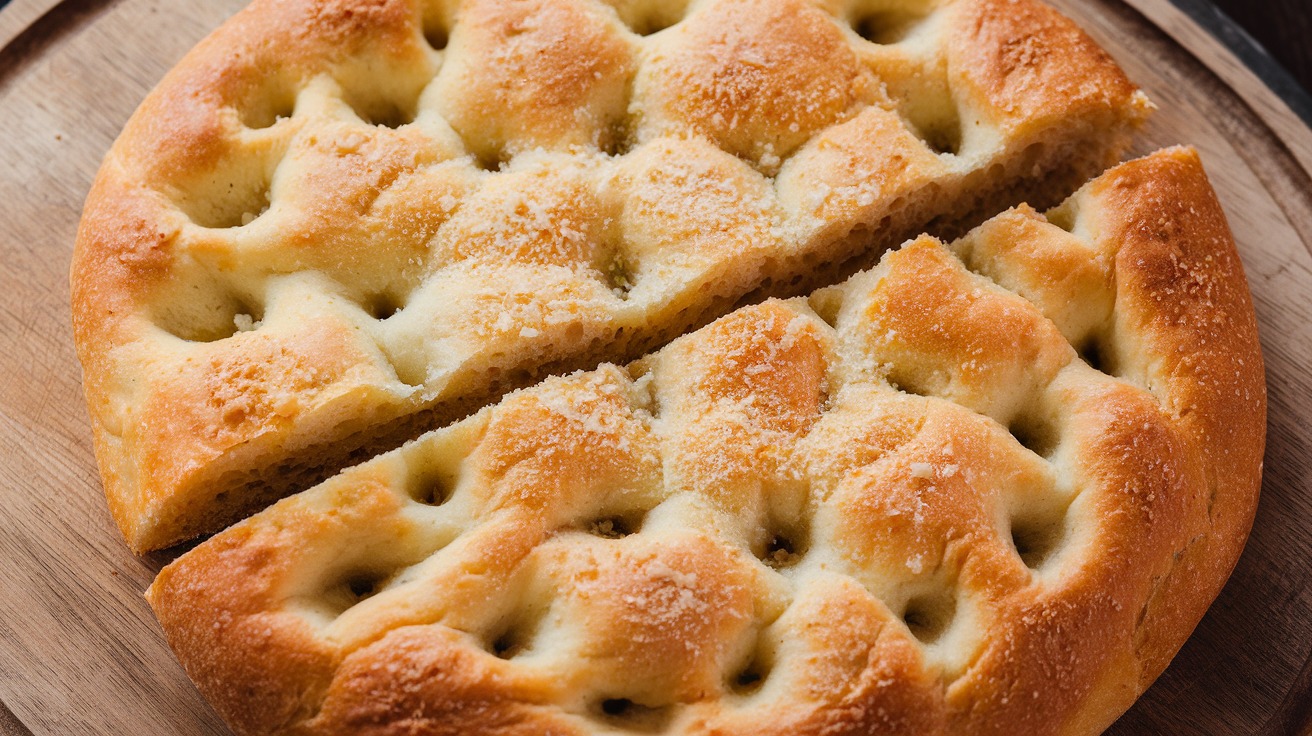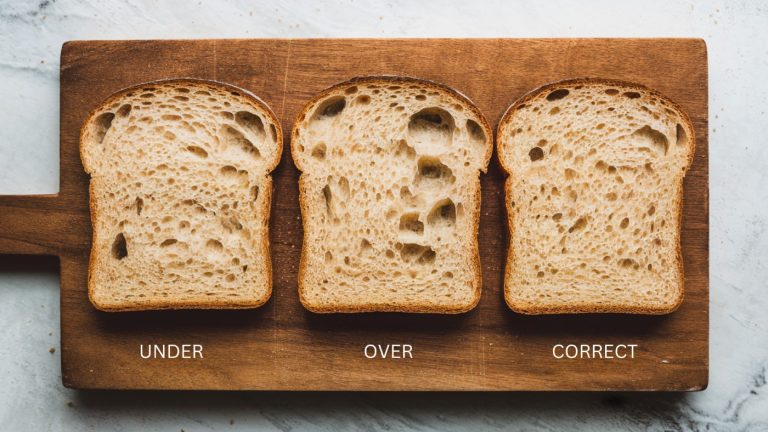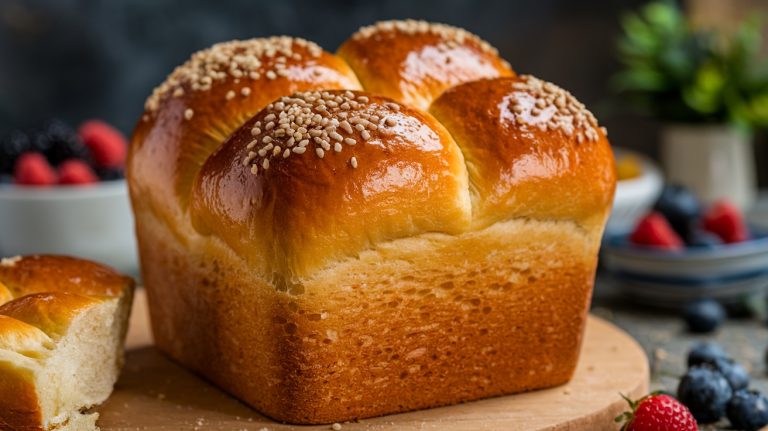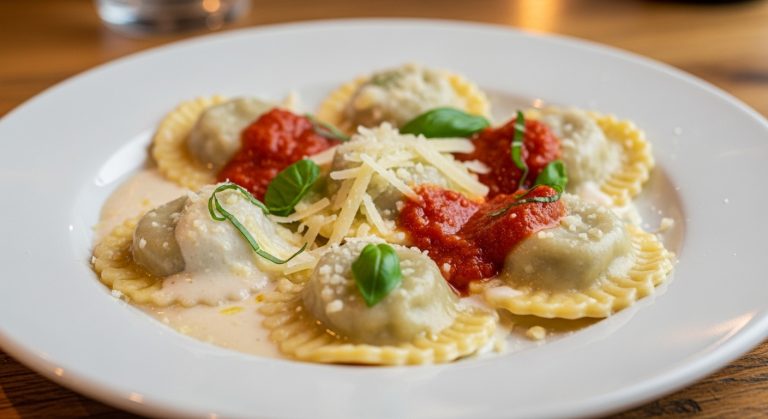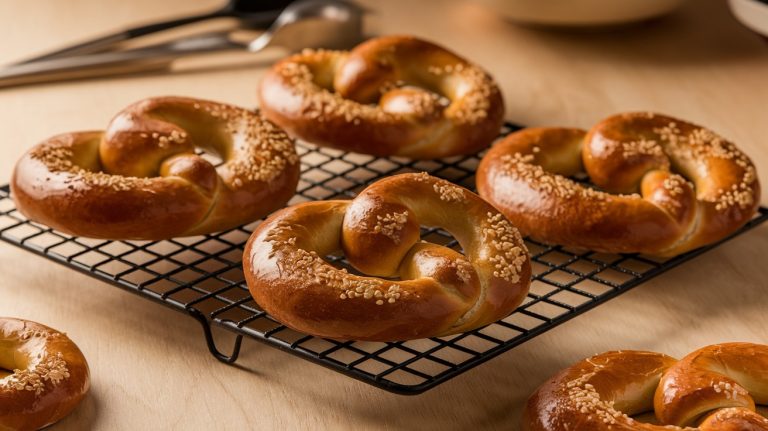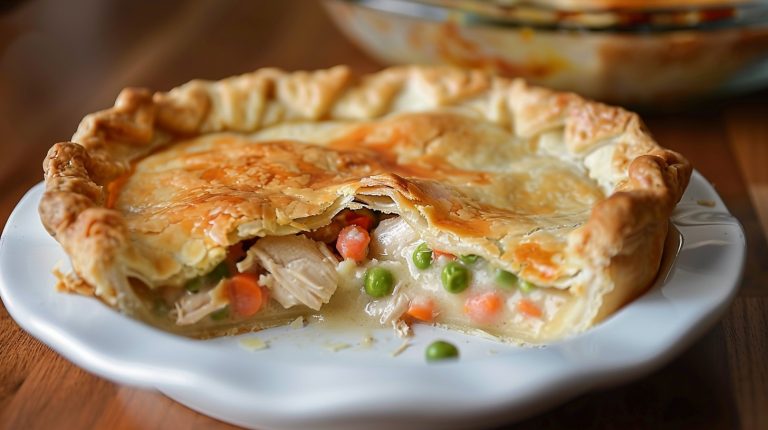Parmesan Focaccia Bread: A Perfect Savory Twist
Parmesan focaccia bread combines traditional Italian flatbread’s fluffy, airy texture with the rich, savory flavor of freshly grated Parmesan cheese. To create a satisfying dough, mix flour, water, yeast, and olive oil.
After a couple of rises, you shape it, create those iconic dimples, and drizzle with olive oil, garlic, and cheese before baking. The result is a golden-brown crust with a soft interior, perfect for enjoying warm alongside soups or as gourmet sandwiches.
If you’re curious about variations and serving ideas, there’s plenty more to explore.
Key Takeaways
- Focaccia is an Italian flatbread made from a simple yeast dough, often enhanced with Parmesan cheese for added flavor.
- The dough is prepared by mixing flour, water, olive oil, and salt, followed by a rising period for a fluffy texture.
- Baking the focaccia at 425°F results in a golden-brown crust, while deep dimples create an appealing texture.
- Serve warm as a side dish, base for sandwiches, or with dips to complement its rich flavor.
- Proper storage allows focaccia to stay fresh for several days, or it can be frozen for longer preservation.
Essential Ingredients
When you set out to make parmesan focaccia bread, understanding the essential ingredients is key to achieving that perfect flavor and texture.
The combination of strong all-purpose flour and bread flour creates a sturdy base, while fresh ingredients like grated parmesan and herbs elevate the taste.
Additionally, incorporating sun-dried tomatoes can add a unique flavor profile and nutritional benefits.
Key Flavor Components
The secret to delicious parmesan focaccia lies in its key flavor components, each playing an essential role in creating that irresistible taste. The foundation starts with flour—either all-purpose or bread flour—that gives your dough structure and texture. Yeast is the magic ingredient that guarantees your focaccia rises beautifully, and a hint of sugar activates it for peak flavor development.
Here’s how these ingredients work together:
| Ingredient | Role in Focaccia | Flavor Contribution |
|---|---|---|
| Flour | Provides structure and texture | Neutral base |
| Yeast | Leavens the dough | Enhances overall flavor |
| Olive Oil | Adds moisture and flavor | Rich, fruity notes |
To elevate your focaccia, don’t forget the savory kick of freshly grated Parmesan cheese and fragrant garlic—both of which complement the fresh rosemary beautifully. A sprinkle of sea salt ties everything together, enhancing those flavors and creating a crispy crust.
Flour Types Comparison
Choosing the right flour is essential for creating the perfect parmesan focaccia, as each type brings its own unique characteristics to the table. All-purpose flour is a great starting point; it offers a balanced texture and flavor thanks to its moderate protein content, which aids in gluten development.
For sourdough lovers, using flour that enhances fermentation can greatly elevate your focaccia game, as seen in the best bread makers for sourdough that cater to various baking needs. If you’re after a chewier, denser loaf, bread flour is your best bet with its higher protein content, resulting in a beautifully airy texture.
For an authentic Italian touch, consider Type 00 flour. This finely milled option provides a soft, elastic dough that enhances the unique texture and flavor of your focaccia.
If you want to add a nutty flavor, whole wheat flour can be used, but keep in mind it may require additional hydration and adjustments for the dough to rise properly.
And, if you’re catering to gluten-free diets, gluten-free flour blends can work, but you’ll likely need to include binding agents like xanthan gum to achieve the right consistency.
Importance of Fresh Ingredients
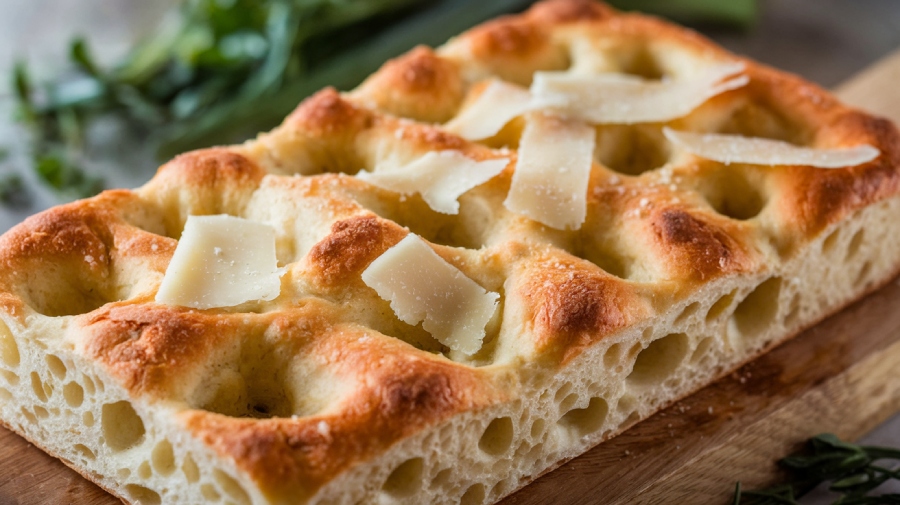
Selecting the right flour sets the foundation for your parmesan focaccia, but fresh ingredients elevate it to a whole new level. When you choose freshly grated Parmesan, you’re opting for a richer, more authentic flavor that pre-packaged cheese simply can’t match. This cheese melts beautifully, creating pockets of savory goodness throughout your bread.
Additionally, using high-protein bread flour can enhance gluten development, guaranteeing that your focaccia has the perfect light and airy texture, similar to that found in sourdough bread techniques.
Incorporating fresh garlic instead of garlic powder adds a subtle sweetness and depth, enhancing the overall flavor profile. Don’t forget about the olive oil—using extra-virgin olive oil not only moistens the dough but also infuses it with a robust flavor that’s vital for delicious focaccia.
Furthermore, adding fresh herbs like rosemary or parsley elevates the bread’s aromatic flavors, transforming it from a simple side dish to a standout centerpiece.
Step-by-Step Preparation
To make delicious Parmesan focaccia bread, start by gathering your ingredients and tools. You’ll need to create a flavorful dough that’ll rise beautifully. The basic ingredients for focaccia include flour, yeast, water, salt, and olive oil, which contribute to its soft and airy texture.
Follow these steps:
- In a bowl, combine 3 cups of bread flour and 2 teaspoons of instant yeast.
- Add 1¼ cups of warm water (about 107°F) and 2 tablespoons of olive oil, mixing until a shaggy dough forms.
- Knead the dough for about 5 minutes with a mixer or 6 minutes by hand until it’s smooth.
Once your dough has come together, coat it with oil and let it rise in a covered bowl at room temperature for about 1 hour, or until it has doubled.
After that, shape the dough into a 9×13 rectangle and transfer it to a greased baking pan, covering it for an additional 20 minutes for the second rise.
Baking
Once your focaccia dough has risen and is ready for baking, understanding the right techniques will guarantee you achieve that perfect texture and flavor.
Start by preheating your oven to 425 degrees, as this high temperature is essential for creating a crispy crust on your bread. Additionally, consider preheating your cast iron skillet, as even heat distribution will result in a better rise and browning.
Once the dough doubles in size during the first rise, shape it into a rectangle and place it in a greased pan. Using your fingers, create deep dimples across the surface, which will hold olive oil and any desired toppings. This not only enhances the flavor but also makes your focaccia visually appealing.
When you’re ready to bake, drizzle a generous amount of oil over the dimples. This adds richness and contributes to that golden-brown finish.
Bake the focaccia for 20-25 minutes, keeping an eye on it to verify it doesn’t overbake. You want that perfect balance between a soft interior and a crispy exterior.
Serving Suggestions
When served warm, parmesan focaccia bread’s fluffy texture and rich flavor shine through. It’s a fantastic side for comforting soups like butternut squash.
Additionally, consider pairing it with a variety of dips to enhance focaccia for a delightful tasting experience.
You can also get creative by using the focaccia as a base for mouthwatering sandwiches or topping it with fresh ingredients for a vibrant appetizer.
Pair it with flavored olive oils or include it on a cheese platter to impress your guests at any gathering.
Perfect Pairings
The joy of savoring Parmesan focaccia bread lies in its incredible versatility, making it a perfect companion for a variety of dishes.
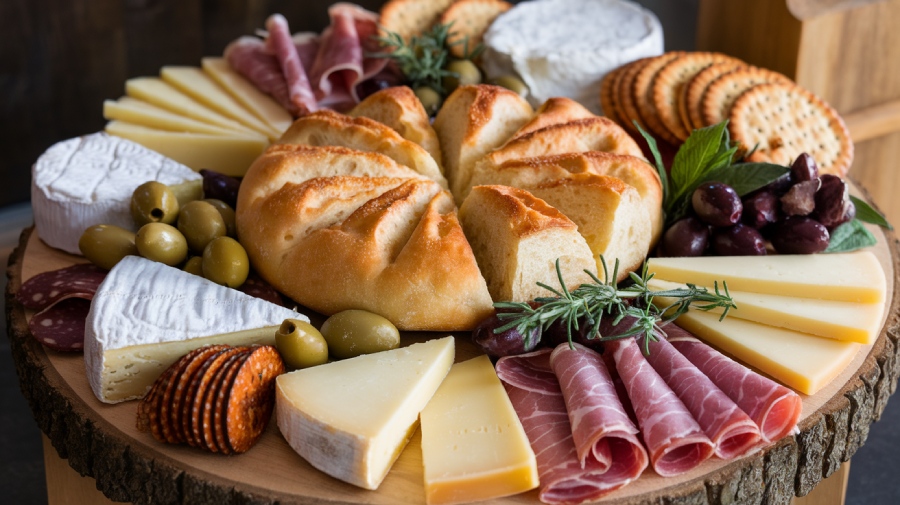
This warm, fragrant bread elevates any meal, enhancing flavors and providing delightful textures. Consider incorporating it into a colorful and textured Focaccia bread charcuterie board that showcases seasonal ingredients and flavor pairings.
Here are three perfect pairings to reflect on:
- Gourmet Sandwiches: Use the focaccia as a base for your favorite sandwiches. Layer roasted vegetables, cured meats, and fresh herbs for a mouthwatering experience that showcases the bread’s rich flavor.
- Dipping Delights: Dip your focaccia in a mix of olive oil infused with balsamic vinegar or lemon. This invigorating contrast highlights the savory notes of Parmesan, making it an irresistible starter for any gathering.
- Charcuterie Board: Serve the focaccia as part of a charcuterie board. Pair it with an assortment of cheeses, olives, and cured meats. This creates an inviting spread that’ll impress your guests and encourage delicious sharing.
Creative Serving Ideas
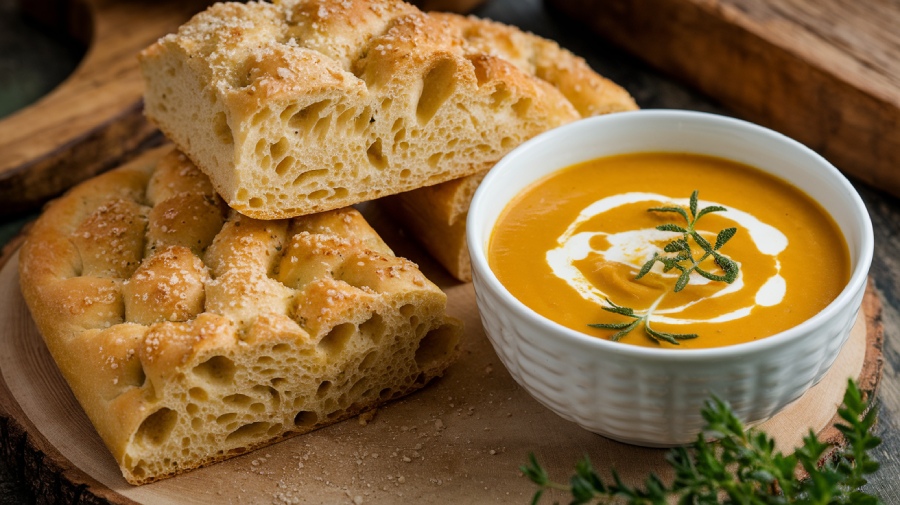
Serve Parmesan focaccia bread warm; you’ll immediately notice its inviting aroma and rich flavor. This delicious Parmesan delight is perfect for a variety of creative serving ideas that elevate any meal.
Pair it with comforting soups like Butternut Squash & Cider Soup for a cozy night in, allowing the bread to soak up the flavorful broth.
You can also use focaccia as a robust base for sandwiches, stuffing it with roasted vegetables, cured meats, or vibrant fresh herbs for a satisfying lunch option.
As a standout appetizer, slice the focaccia into bite-sized pieces and serve it alongside an array of dips, such as tangy marinara sauce or sweet balsamic reduction.
Don’t forget about brunch! Top your warm focaccia with poached eggs, creamy avocado, and a sprinkle of chili flakes for a delicious twist on classic brunch fare.
Storage Tips
Proper storage is essential to keep your homemade Parmesan focaccia fresh and flavorful. Here are some tips to guarantee your bread remains delicious for days to come:
1. Room Temperature: If you plan to enjoy your focaccia within 2-4 days, wrap it tightly in plastic wrap. This helps maintain moisture and keeps the bread soft.
Just make sure to allow it to cool completely before wrapping.
2. Freezing: For longer storage, slice your focaccia and place it in a zip-top bag. Before sealing, drizzle a bit of olive oil to preserve its quality.
Focaccia can be frozen for up to 3 months, making it a perfect option for future meals.
3. Reheating: When you’re ready to enjoy your focaccia, reheat it in a toaster oven or regular oven to restore that crispy texture.
Avoid microwaving, as it can make the bread too soft. If it’s frozen, allow it to thaw overnight in the refrigerator for the best taste and texture.
Nutritional Information
When enjoying a slice of Parmesan focaccia bread, you’ll find it satisfies your cravings and offers a balanced nutritional profile. Each standard serving contains approximately 194 calories, making it a flavorful yet moderate option for any meal or snack. The bread provides 26 grams of carbohydrates, primarily from the flour, serving as a great source of energy.
You’ll get 5 grams of protein per serving, which supports muscle repair and overall body function. The focaccia contains 8 grams of fat, with just 1 gram of saturated fat, mainly derived from the high-quality olive oil and savory Parmesan cheese used in the recipe. This combination enhances the flavor and contributes to its nutritional value.
Additionally, each serving includes 258 milligrams of sodium. While sodium is essential for maintaining fluid balance, it’s best consumed in moderation, so be mindful of your overall intake.
Frequently Asked Questions
What Makes Focaccia Bread Different?
Imagine a golden canvas waiting for vibrant flavors to come alive.
Focaccia bread stands out with its dimpled surface, creating perfect pockets for olive oil and toppings. This bread boasts a rich, moist crumb thanks to its higher oil content, while the simple yeasted dough requires minimal kneading.
With just a few dimples before baking, you achieve a crispy crust and airy interior, making focaccia a delightful treat that’s both versatile and satisfying.
Why Is Focaccia Bread so Good?
Focaccia bread’s incredible taste comes from its light, airy texture and rich flavor.
You’ll love how the olive oil seeps into those signature dimples, creating a moist, savory bite.
The bread’s versatility lets you enjoy it as a side, sandwich, or snack.
Plus, its easy preparation invites you to experiment with toppings and flavors, making each loaf uniquely yours.
Once you try it, you’ll understand why focaccia is simply irresistible!
Is Focaccia Healthier Than White Bread?
Yes, focaccia can be healthier than white bread. It’s often made with olive oil, providing healthy fats that white bread lacks.
You’ll find higher fiber content in whole grain versions, promoting better digestion and sustained energy. Plus, focaccia can be topped with nutrient-rich ingredients, enhancing its nutritional value.
Its longer fermentation process also boosts nutrient absorption, making it a more satisfying choice. So, when you choose focaccia, you’re opting for a more wholesome option.
What Is Focaccia Bread Good With?
Focaccia bread’s versatility makes it a fantastic addition to any meal.
You’ll love dipping it in olive oil, especially when infused with herbs or lemon. It pairs beautifully with soups like butternut squash or minestrone, enhancing their flavors.
If you’re in the mood for a sandwich, focaccia holds up well under roasted vegetables or cured meats.
Don’t forget to enjoy it with salads or dunk it in marinara for a savory twist!
Fresh from the Oven: Bringing Family Together
Ultimately, baking parmesan focaccia bread is like finding a hidden gem in your kitchen. With its golden crust and fluffy interior, you’ll soon realize it’s worth every minute spent preparing it.
Whether you enjoy it fresh from the oven or as a delightful sandwich base, this bread’s rich flavor and aroma will have your family and friends return for seconds.
So roll up your sleeves and let your culinary creativity shine!

